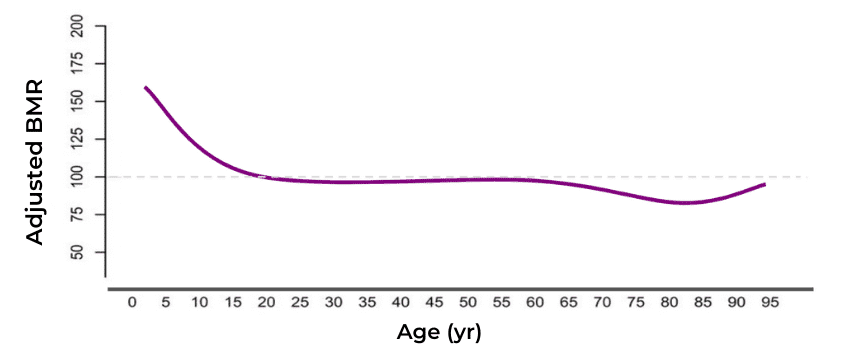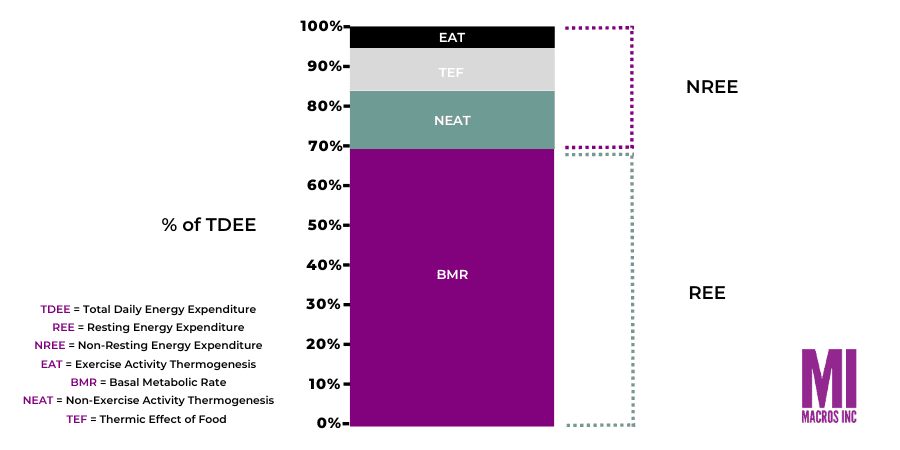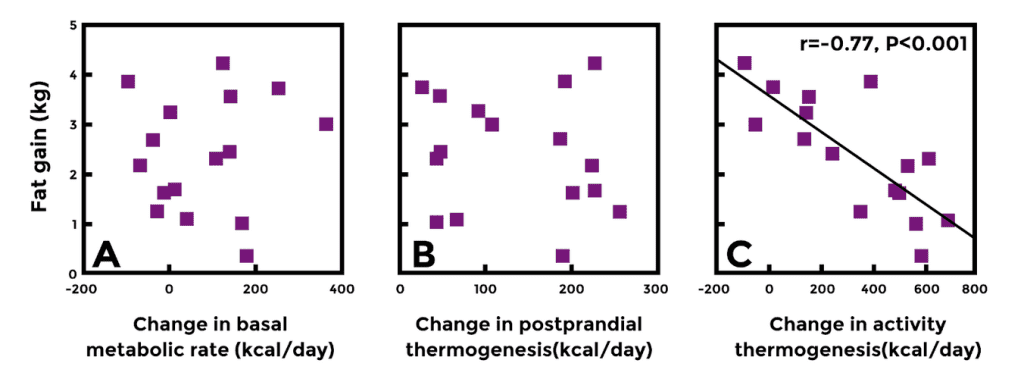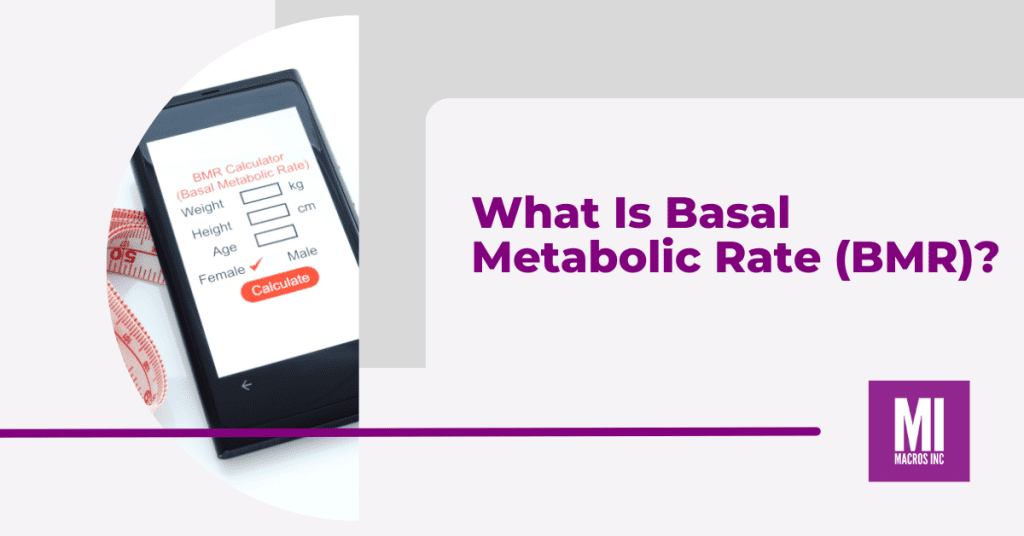BMR, or basal metabolic rate, refers to the amount of calories your body uses just to stay alive. Essentially, BMR represents the total amount of energy/calories your body would use if you laid completely still in a bed all day and did nothing (sort of like the people in the movie WALL-E).
In this article, we’ll discuss what determines your BMR and the factors that affect it, how to calculate BMR and how you can utilize it to help you with weight loss and to reach your health and fitness goals.
Jump to a Topic
What Determines Your BMR?
It turns out that your body actually does a lot of things in a given day that requires a large amount of energy, even without you knowing about it or paying attention to it.
The biggest determiner of your BMR is your total body size; the larger you are, the more calories your body burns to maintain itself.
Generally speaking there are parts of your body that are more metabolically active than others. For example, your organs like your heart, lungs, brain, and kidneys are really active and require a lot of calories to function. Muscle tissue is also fairly metabolically active, even at rest. Your adipose tissue (fat tissue) is less active than other tissue, but it still utilizes calories to maintain itself.

Other things that affect your BMR are your age, levels of thyroid hormones, and our environment. Once we reach adulthood, our BMR tends to slow down very slightly as we age, however they don’t begin slowing down until much later in life (over 60 years of age).
BMR vs RMR
BMR is often used interchangeably with the term RMR, or resting metabolic rate. BMR is your true metabolic rate at full rest, while resting metabolic rate includes the bare minimum of activity in a day, such as walking around your house, using the bathroom, eating, sweating or shivering to maintain body temperature, and other very minimal effort tasks. Of the two, BMR is used more often as it is generally easier and more accurate to measure.
Understanding Metabolism (BMR, RMR, NEAT, TDEE)
In addition to BMR, you have probably also heard the following terms: RMR, TDEE, and NEAT. Let’s discuss these and how they all relate to overall metabolism.
Total Daily Energy Expenditure (TDEE)
When we hear the word metabolism, what we should actually be thinking about is the total amount of chemical energy our body “metabolizes” in a day to meet our energy demands. That total number is represented by what we call our Total Daily Energy Expenditure or our TDEE.
Components of Metabolism
Our TDEE is actually the total of several different components of our metabolism:
- Basal Metabolic Rate (BMR): Resting Energy Expenditure is really just our BMR, or the energy we expend just to keep our body functioning while not moving at all.
- Thermic Effect of Food (TEF): TEF is the energy it takes to breakdown the food we eat.
- Non-Exercise Activity Thermogenesis (NEAT): NEAT is the energy we use to move around and do physical activities that are not structured exercise.
- Exercise Activity Thermogenesis (EAT): EAT is the energy we use to engage in structured exercise.
- Resting Energy Expenditure (REE) and Non-Resting Energy Expenditure (NREE): These four components can actually be binned into two categories: our resting energy expenditure and our non-resting energy expenditure. BMR is really the only one that falls under the resting energy expenditure, while TEF, NEAT, and EAT fall under non-resting energy expenditure.
- Non-Resting Energy Expenditure (NREE): NREE is the energy it takes your body to do everything else, which fundamentally boils down to three main things: TEF, NEAT, and EAT.
- Caffeine
- Capsaicin (chili peppers)
- Resistance Training
While all of these are components of our TDEE, or total metabolism, they do not all contribute the same amount. See the graphics depicting the relative contribution of each of these four categories to your TDEE.

Role of Exercise in Energy Balance
Note that of the four categories, EAT is much lower than your REE and your EAT, and for most people is on par with their TEF. This means that in the context of energy balance overall, exercise plays a small role. However, that doesn’t mean exercise is not important, it just has a slightly different overall purpose
Why Knowing Your BMR is Useful for Weight Loss
If you were dialed in while reading the section above you may notice that your BMR actually makes up the largest portion of your overall energy expenditure in a day. This means that understanding a person’s BMR is really important for finding ways to accurately predict what a person’s total calorie needs might be.
In fact, if you look at all the “calorie calculators” created by scientists, most of them essentially predict BMR based on your height, weight, and age and then multiply that by your activity to determine your total needs.
This means that BMR is really useful as a tool to estimate your starting calories for any sort of goal that involves changing your body weight.
However, there is some really important context here to discuss.
BMR Considerations
The first is that while your BMR makes up a large portion of your TDEE, the utility of knowing your exact BMR versus a rough estimate is relatively small.
In even extreme cases where someone’s measured BMR and estimated BMR are off by 15-20%, the overall effect that has on estimated total calorie needs may be ~200-300 kcals per day in most situations.
This is actually a smaller error than if someone mis-estimates their lifestyle based activity level which is often a difference of 400-500 calories per day.
Also, it turns out that BMR is not actually a very useful tool for predicting weight gain or weight loss. In fact, BMR does not have any meaningful predictive value for determining who is going to gain weight or lose weight, indicating that your resting metabolism is not a primary mechanism for weight loss or weight gain in most people.
In actuality, our physical activity levels, specifically our NEAT, are a much better predictor of weight loss or weight gain.
So the best way to think about the utility of BMR is that it is something we can estimate relatively easily and relatively accurately to help us determine a starting point for calorie intake for either weight loss or weight gain goals.

How to Calculate Your BMR
There are many different methods of calculating BMR, but they are all based on the same principle: they estimate your BMR based on your height, weight, age, and some also utilize body composition.
The three most popular equations are the Harris-Benedict, Mifflin-St Jeor, and the Katch-McArdle equations. Each of these equations have slightly different weights on the variables but all utilize the same underlying metrics and have similar accuracy.
The Harris-Benedict Equation is one of the oldest and simplest methods to estimate BMR. It takes into consideration gender, weight, height, and age to calculate BMR.
Now let’s delve into the formulas for each of these calculation methods, along with examples showcasing the calculation and calorie total:
Harris-Benedict Equation:
For Men: BMR = 88.362 + (13.397 × weight in kg) + (4.799 × height in cm) – (5.677 × age in years)
For Women: BMR = 447.593 + (9.247 × weight in kg) + (3.098 × height in cm) – (4.330 × age in years)
Example: Let’s consider a 25-year-old male weighing 180 lbs and measuring 6 ft 2 inches (or 74 inches) in height. Weight in kg = 180 lbs / 2.205 = 81.63 kg Height in cm = 6 ft 2 inches * 30.48 + 2 inches * 2.54 = 187.96 cm
BMR = 88.362 + (13.397 × 81.63 kg) + (4.799 × 187.96 cm) – (5.677 × 25 years)
BMR = 88.362 + 1095.677 + 901.581 – 141.925
BMR = 2044.695 calories
Mifflin-St. Jeor Equation:
For Men: BMR = (10 × weight in kg) + (6.25 × height in cm) – (5 × age in years) + 5
For Women: BMR = (10 × weight in kg) + (6.25 × height in cm) – (5 × age in years) – 161
Example: Let’s consider a 30-year-old female weighing 140 lbs and measuring 5 ft 6 inches (or 66 inches) in height. Weight in kg = 140 lbs / 2.205 = 63.49 kg Height in cm = 5 ft 6 inches * 30.48 + 6 inches * 2.54 = 167.64 cm
BMR = (10 × 63.49 kg) + (6.25 × 167.64 cm) – (5 × 30 years) – 161
BMR = 634.9 + 1047.75 – 150 – 161
BMR = 1371.65 calories
Katch-McArdle Equation:
Formula: BMR = 370 + (21.6 × LBM in kg)
Example: Let’s consider a 35-year-old male weighing 160 lbs with a body fat percentage of 20%. Weight in kg = 160 lbs / 2.205 = 72.57 kg Lean Body Mass (LBM) = (1 – Body Fat Percentage) × Weight LBM = (1 – 0.20) × 72.57 kg = 58.06 kg
BMR = 370 + (21.6 × 58.06 kg)
BMR = 1626.5 calories
How to Boost Your BMR
Boosting BMR has been a topic of discussion for many decades, and while there are some things you can do to boost BMR almost all of them are temporary and have a very small effect… or they require a prescription from a physician.
Here are a list of things that temporarily increase your BMR:
You might notice this list is very small, and that is because there are very few things that actually have any measurable impact on your BMR. The best thing to focus on for your overall metabolism, your TDEE, is to ensure you are staying physically active and keeping your NEAT levels high during your daily life.
In Summary
Understanding your basal metabolic rate (BMR) and daily calorie expenditure is crucial for achieving and maintaining a healthy weight. By gaining knowledge about your body’s energy needs, you can make informed changes that yield tangible results.
However, it’s essential to consult a professional, such as a nutrition coach who can consider your medical history and nutrition goals to develop a personalized plan tailored to your specific needs. Seeking professional guidance ensures that you approach weight management in a safe and effective manner.
Try our nutrition coaching, for free!
Be the next success story. Over 30,000 have trusted Macros Inc to transform their health.
Simply fill out the form below to start your 14-day risk-free journey. Let's achieve your goals together!


